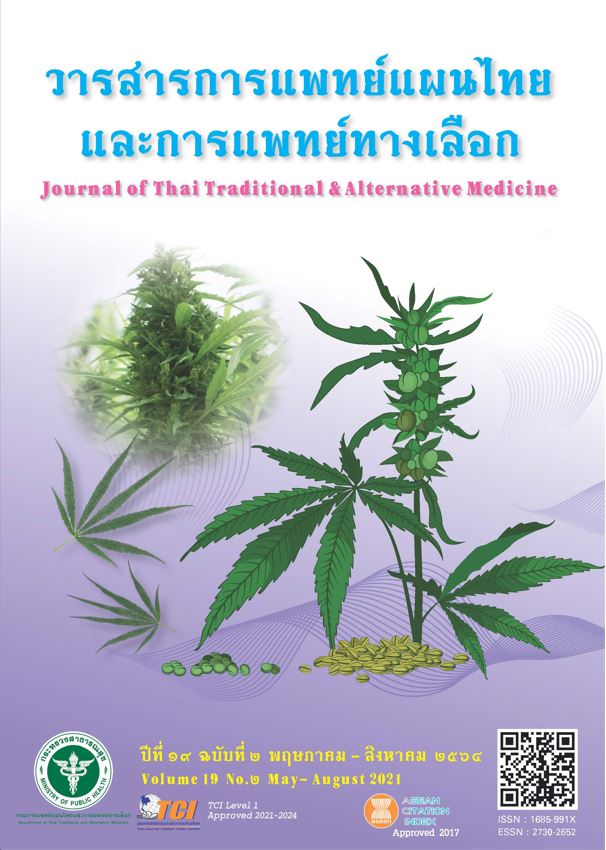Isolation of Pinostrobin, a Chemical Marker from Fingerroots for Quality Control Purposes
Main Article Content
Abstract
Pinostrobin is a major constituent of fingerroot or krachai in Thai [Boesenbergia rotunda (L.) Mansf.]. From
preliminary study, isolation of high-purity pinostrobin could be possible. This compound will be used as a chemical marker in method development for quality control of fingerroot for which no standard method had been established for this medicinal plant in Thailand. The aims of this study were to study the isolation method of pinostrobin from fingerroot and to develop a chemical identification method of fingerroot using the thin layer chromatography (TLC) technique. Isolation of pinostrobin was performed by maceration of fingerroot with 95% ethanol and evaporation of the filtrate to gain yellow precipitate. Sephadex LH20 gel filtration was performed and pale yellow powder was obtained. Recrystallization was carried on to obtain off-white powder. Structural identification of the isolated compound was undertaken using spectroscopic analysis. A TLC method using pinostrobin as a chemical marker was developed. Sample was prepared by extracting fingerroot powder with methanol, using silica gel 60 as stationary phase and a mixture of dichloromethane and methanol (70:1) as mobile phase, and then sprayed with NP/PEG. Results showed that 97.06% pure pinostrobin could be isolated with 0.86% yield. Using this uncomplicated
method, the high-purity and high-yield compound could be obtained. In the TLC analysis, a spot of pinostrobin at the Rf value of 0.95 was observed. This method could be further used for quality control of fingerroot.
Article Details
References
Office of the Royal Society. Royal Institute Dictionary 2011. Bangkok: Siriwattana Interprint Co. Ltd.; 2013. p.
(in Thai)
Department of Thai Traditional and Alternative Medicine. Monographs of Selected Thai Materia Medica
Volume 2. Bangkok: Amarin Printing and Publishing Co., Ltd.; 2015. p. 21-5. (in Thai)
Nurrachma MY, Fadliyah H, Meiyanti E. Fingerroot (Boesenbergia pandurata): a prospective anticancer therapy. Indones. J. Cancer Chemoprevent. 2018;9(2):102-9.
Ongwisespaiboon O, Jiraungkoorskul W. Fingerroot, Boesenbergia rotunda and its aphrodisiac activity.
Pharmacogn Rev. 2017;11(21):27-30.
Tan BC, Tan SK, Wong SM, Ata N, Abd. Rahman N, Khalid N. Distribution of flavonoids and cyclohexenyl
chalcone derivatives in conventional propagated and in vitro-derived field-grown Boesenbergia rotunda
(L.) Mansf. Evid Based Complement Alternat Med. 2015;2015:451870.
Tuntiwachwuttikul P, Pancharoen O, Reutrakul V, Byrne LT. (1´RS, 2´SR, 6´RS)-(2,6-dihydroxy-4-methoxyphenyl)-[3´-methyl-2´-(3´´-methylbut-2´´-enyl)-6´-phenylcyclohex-3´-enyl]methanone (panduratin A)-A constituent of the red rhizomes of a variety of Boesenbergia pandurata. Aust J Chem. 1984;37(2):449-53.
Mahidol C, Tuntiwachwuttikul P, Reutrakul V, Taylor WC. Constituents of Boesenbergia pandurata (syn.
Kaempferia pandurata). III. isolation and synthesis of (†)-boesenbergin B. Aust J Chem. 1984;37(8):1739-45.
Mahidol C, Tuntiwachwuttikul P, Reutrakul V. Chemical investigation of Zingiberaceous plants. NRCT-JSPS Rattanakosin Bicentennial Joint Seminar on Chemistry of Natural Products; 2-6 August 1982; Bangkok, Thailand:
15.
Kanchanapiboon J, Kongsa U, Pattamadilok D, Kamponchaidet S, Wachisunthon D, Poonsatha S, Tuntoaw S.
Boesenbergia rotunda extract inhibits Candida albicans biofilm formation by pinostrobin and pinocembrin. J
Ethnopharmacol. 2020;261:113193.
Patel NK, Jaiswal G, Bhutani KK. A review on biological sources, chemistry and pharmacological activities of
pinostrobin. Nat Prod Res. 2016;30(18):2017-27.
Wiyono L, Rahmawanti RA, Edina BC, Azizah NN, Fadilah F, Paramita RI, Purwaningsih EH, Fadilah F.
Isolation, synthesis nanoparticle, and in-vitro test of pinostrobin from Kaempferia pandurata on MCF-7 and
MDAMB-231 breast cancer cell. Research J. Pharm. and Tech. 2020;13(6).
Ching AYL, Wah TS, Sukari MA, Lian GEC, Rahmani M, Khalid K. Characterization of flavonoid derivatives
from Boesenbergia rotunda (L.). Malaysian J Anal Sci. 2007;11(1):154-9.


